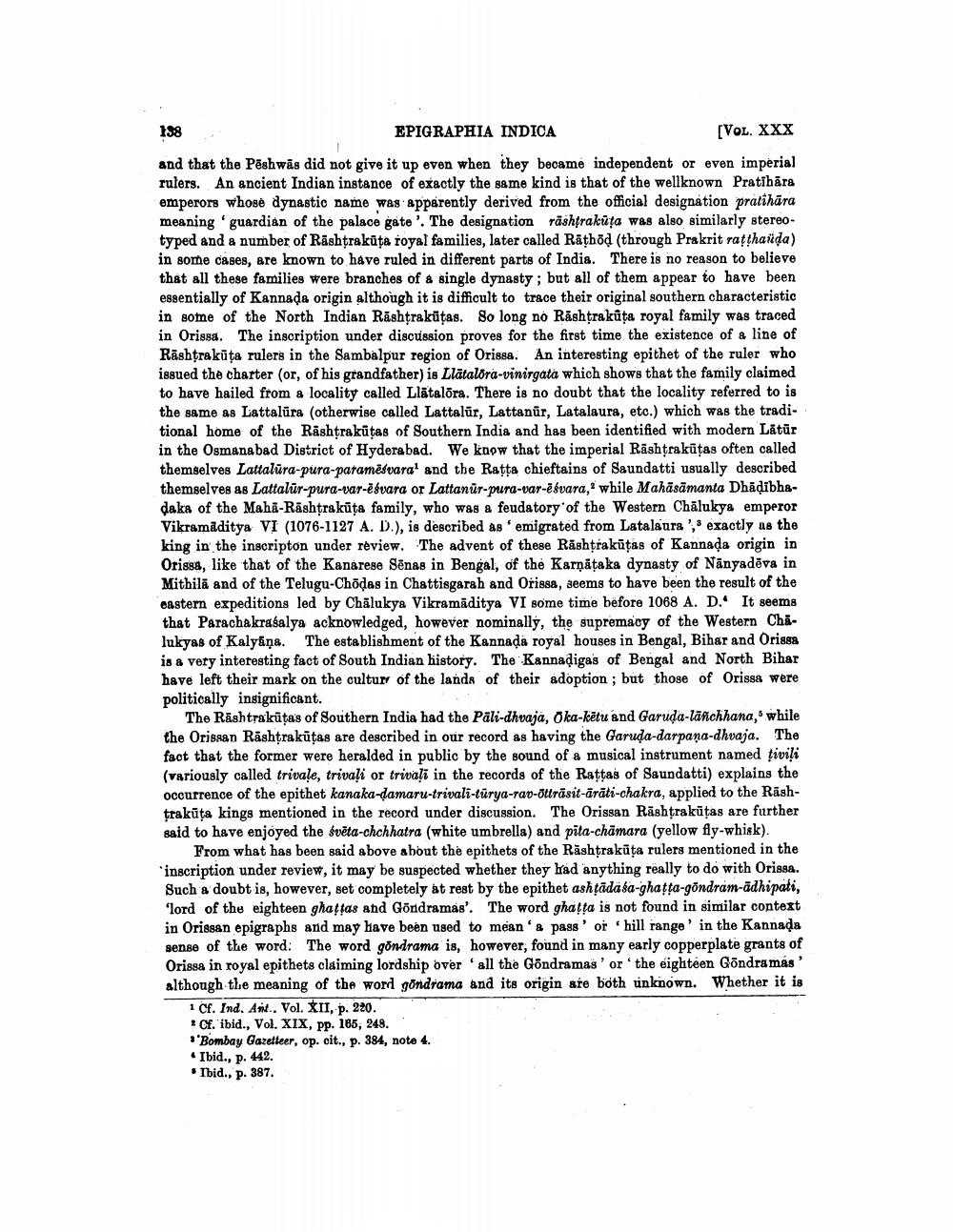________________
188
EPIGRAPHIA INDICA
[VOL. XXX and that the Pēshwās did not give it up even when they became independent or even imperial rulers. An ancient Indian instance of exactly the same kind is that of the wellknown Prathāra emperors whose dynastic name was apparently derived from the official designation pratihāra meaning 'guardian of the palace gate'. The designation räshfrakūta was also similarly stereotyped and a number of Rāshtrakūta royal families, later called Rathod (through Prakrit ratthaida) in some cases, are known to have ruled in different parts of India. There is no reason to believe that all these families were branches of a single dynasty ; but all of them appear to have been essentially of Kannada origin although it is difficult to trace their original southern characteristic in some of the North Indian Rāshțrakūtas. So long nó Rāshtrakūta royal family was traced in Orissa. The inscription under discussion proves for the first time the existence of a line of Rāshtrakūta rulers in the Sambalpur region of Orissa. An interesting epithet of the ruler who issued the charter (or, of his grandfather) is Llātalora-vinirgata which shows that the family claimed to have hailed from a locality called Llätalora. There is no doubt that the locality referred to is the same as Lattalüra (otherwise called Lattalür, Lattanür, Latalaura, etc.) which was the traditional home of the Rashtrakūtas of Southern India and has been identified with modern Latur in the Osmanabad District of Hyderabad. We know that the imperial Rashtrakūtas often called themselves Lattalura-pura-paramèsvara' and the Ratta chieftains of Saundatti usually described themselves as Lattalur-pura-var-esvara or Lattanür-pura-var-ēsvara,' while Mahāsāmanta Dhādībhadaka of the Mahā-Rāshtrakūta family, who was a feudatory of the Western Chālukya emperor Vikramaditya VI (1076-1127 A.D.), is described as emigrated from Latalaura'exactly as the king in the inscripton under review. The advent of these Rashtrakūtas of Kannada origin in Orissa, like that of the Kanarese Sēnas in Bengal, of the Karnataka dynasty of Nânyadēva in Mithila and of the Telugu-Chūdas in Chattisgarah and Orissa, seems to have been the result of the eastern expeditions led by Chalukya Vikramaditya VI some time before 1068 A. D. It seems that Parachakrasalya acknowledged, however nominally, the supremacy of the Western Chi. lukyas of Kalyana. The establishment of the Kannada royal houses in Bengal, Bihar and Orissa is a very interesting fact of South Indian history. The Kannadigas of Bengal and North Bihar have left their mark on the culture of the lands of their adoption ; but those of Orissa were politically insignificant.
The Rashtrakūta's of Southern India had the Pali-dhvaja, Oka-kētu and Garuda-lānichhana, while the Orissan Rashtrakūtas are described in our record as having the Garuda-darpana-dhvaja. The fact that the former were heralded in public by the sound of a musical instrument named ţivili (variously called trivale, trivali or trivali in the records of the Rattas of Saundatti) explains the occurrence of the epithet kanaka-damaru-trivali-türya-rav-otträsit-äräti-chakra, applied to the Räshtrakūta kings mentioned in the record under discussion. The Orissan Rashtrakūtas are further said to have enjoyed the svēta-chchhatra (white umbrella) and pita-chämara (yellow fly-whisk).
From what has been said above about the epithets of the Rashtrakūţa rulers mentioned in the 'inscription under review, it may be suspected whether they had anything really to do with Orissa. Such a doubt is, however, set completely at rest by the epithet ashțādaśa-ghatta-göndram-adhipati, 'lord of the eighteen ghattas and Göndramas'. The word ghatta is not found in similar context in Orissan epigraphs and may have been used to mean& pass' or hill range' in the Kannada sense of the word: The word göndrama is, however, found in many early copperplate grants of Orissa in royal epithets claiming lordship over all the Göndramas' or 'the eighteen Gondra mas' although the meaning of the word göndrama and its origin ate both unknown. Whether it is
1 Cf. Ind. Ant. Vol. XII, p. 220. * Cf. ibid., Vol. XIX, pp. 186, 248. 'Bombay Gazetteer, op. cit., p. 384, note 4.
Ibid., p. 442. • Ibid., p. 387.




